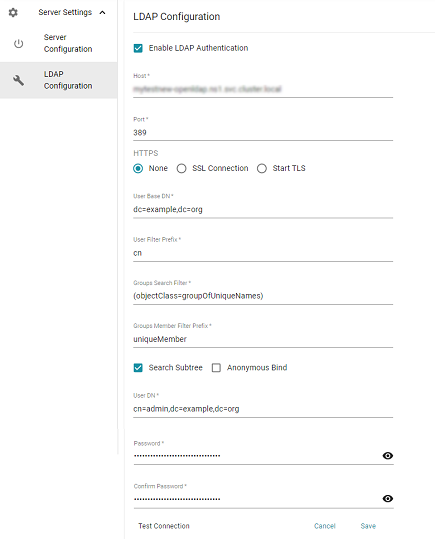Configure Graph Lakehouse for LDAP Authentication
By default, the Graph Lakehouse front end console is configured to use authentication and authorization credentials maintained by Graph Lakehouse itself. You can also configure the Graph Lakehouse front end console to use a specified LDAP or directory service to authenticate users and authorize Graph Lakehouse operations based on user membership in LDAP groups. See Create and Manage Roles from the Console for information on creating uer roles and granting or revoking permissions to access specific Graph Lakehouse database objects (graphs, views, and queries), whether you are using local Graph Lakehouse or LDAP service authentication of users.
Define an LDAP Configuration
To configure the Graph Lakehouse front end console and Graph Lakehouse to use LDAP authentication:
- Select LDAP Configuration from the Server Settings list to display the LDAP Configuration screen.
- On the LDAP Configuration screen, configure the connection to your Graph Lakehouse deployment by selecting the Enable LDAP Authentication checkbox and then choosing among the various radio button options and supplying values for the required fields.
Selecting the Enable LDAP Authentication checkbox enables front end authentication using the the LDAP configuration.

Field entries for the LDAP Configuration are the following:
- Enable LDAP Authentication checkbox: Selection that allows you to enable front end authentication using the LDAP configuration.
- Host: Host name or IP address of the LDAP directory server.
- Port: The port used to connect to the LDAP directory server.
- HTTPS radio buttons: Specifies whether the directory server uses an SSL (LDAPS) or a StartTLS protocol connection.
- User Base DN: LDAP distinguished name that contains users than can be authenticated, for example:
dc=example,dc=org. - User Filter Prefix: Property name that a user name is mapped to, for example:
cn. - Groups Search Filter: Filter used to search for LDAP group names, for example:
(objectClass=groupOfUniqueNames). - Groups Member Filter Prefix: Property name prefix used for searching if user is part of group, for example:
uniqueMember. - Search Subtree checkbox: Option to specify whether to search LDAP subtrees.
- Anonymous Bind checkbox: Option to specify whether the Graph Lakehouse front end console connects to the directory server anonymously.
- User DN: Full distinguished name of the account that the Graph Lakehouse front end console will bind against to perform authentication on the directory server, for example:
cn=admin,dc=example,dc=org. - Password: Password specified for the User DN.
- When you have supplied all of the necessary connection details, click Test Connection at the bottom of the screen to ensure that the connection with your LDAP directory service can be made.
If the test fails, adjust the values as needed and test the connection again.
- Click Save to save the connection.
Enable LDAP Authentication for the Console
To use an LDAP configuration to authenticate Console login and authorize Graph Lakehouse operations users are able to perform, you need to update settings in the Graph Lakehouse settings.conf configuration file. That is, to enable external LDAP authentication to the console, you need to configure the following options in the Graph Lakehouse settings.conf file (located in the InstallDir/anzograph/config directory) :
enable_acl=true enable_external_auth=true
After updating the settings in the Graph Lakehouse configuration file, you need to restart Graph Lakehouse for the new settings to take effect. For example:
<install_path>/anzograph/bin/azgctl -restart
With these new ACL settings, Graph Lakehouse front end console users will be authenticated against an externally- configured LDAP directory service. A user's LDAP group membership information will be passed to Graph Lakehouse along with any submitted SPARQL query request or statement they submit to help in authorizing requests. Where Graph Lakehouse roles are already defined that match the names of LDAP groups a user is a member of, the Graph Lakehouse assigned role permissions will determine a user's authorization or permission to execute any submitted SPARQL request.
See Access Control Basics and Terminology for more information on Graph Lakehouse ACL operations and additional methods of integrating LDAP directory services with Graph Lakehouse.
You can now use the front end console using LDAP directory service authentication of users. For more information on using the front end console, see Use the Query & Admin Console. Also refer to Create and Manage Roles from the Console for information on defining or updating roles that control Console user access and permissions.